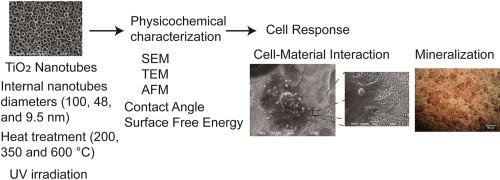Materials Chemistry and Physics ( IF 4.3 ) Pub Date : 2021-08-13 , DOI: 10.1016/j.matchemphys.2021.125137 Robinson Aguirre Ocampo 1 , Mónica Echeverry-Rendón 2, 3 , Sara Robledo 2 , Félix Echeverría Echeverría 1

|
Titanium implants have been extensively used in orthopedic and dental applications due to their high performance at the biomechanical level and their excellent biocompatibility. Currently, in bone implants, the design of surfaces is used to address a biological behavior that includes the improvement of osseointegration or the immobilization of active molecules. This paper aimed to describe the effect of the nanotube characteristics on the adhesion, proliferation, and mineralization of osteoblasts. To the best of our knowledge, the effect of reduced internal diameters (≈10 nm) with and without UV irradiation and with and without heat treatment on osteoblast adhesion, proliferation, and mineralization has not been reported. All the anodic coatings were biocompatible; however, surface characteristics such as topography, wettability, charge, and phase composition could affect osteoblast adhesion, proliferation, and mineralization. Nanotubular coatings with higher roughness and UV irradiation improved early cell adhesion; however, the nanotubes with a diameter of about 10 nm and composed entirely by rutile or anatase phases negatively affected early cell adhesion. The number of filopodia rises with the reduction in the internal diameter of the porous anodic coating, and the mineralization had the same behavior, namely: a decrease of the internal diameter induced a superior rate of matrix mineralization.
中文翻译:

TiO2 纳米管尺寸、热处理和紫外线照射对成骨细胞行为的影响
由于其在生物力学水平上的高性能和优异的生物相容性,钛植入物已广泛用于骨科和牙科应用。目前,在骨植入物中,表面设计用于解决包括改善骨整合或固定活性分子在内的生物学行为。本文旨在描述纳米管特性对成骨细胞的粘附、增殖和矿化的影响。据我们所知,在有和没有紫外线照射以及有和没有热处理的情况下,减小内径(≈10 nm)对成骨细胞粘附、增殖和矿化的影响尚未见报道。所有的阳极涂层都是生物相容的;然而,表面特性,如形貌、润湿性、电荷、和相组成会影响成骨细胞的粘附、增殖和矿化。具有更高粗糙度和紫外线照射的纳米管涂层可改善早期细胞粘附;然而,直径约 10 nm 且完全由金红石或锐钛矿相组成的纳米管会对早期细胞粘附产生负面影响。丝状伪足的数量随着多孔阳极涂层内径的减小而增加,并且矿化具有相同的行为,即:内径减小导致基质矿化率较高。直径约 10 nm 且完全由金红石或锐钛矿相组成的纳米管对早期细胞粘附产生负面影响。丝状伪足的数量随着多孔阳极涂层内径的减小而增加,并且矿化具有相同的行为,即:内径减小导致基质矿化速率较高。直径约 10 nm 且完全由金红石或锐钛矿相组成的纳米管对早期细胞粘附产生负面影响。丝状伪足的数量随着多孔阳极涂层内径的减小而增加,并且矿化具有相同的行为,即:内径减小导致基质矿化速率较高。











































 京公网安备 11010802027423号
京公网安备 11010802027423号